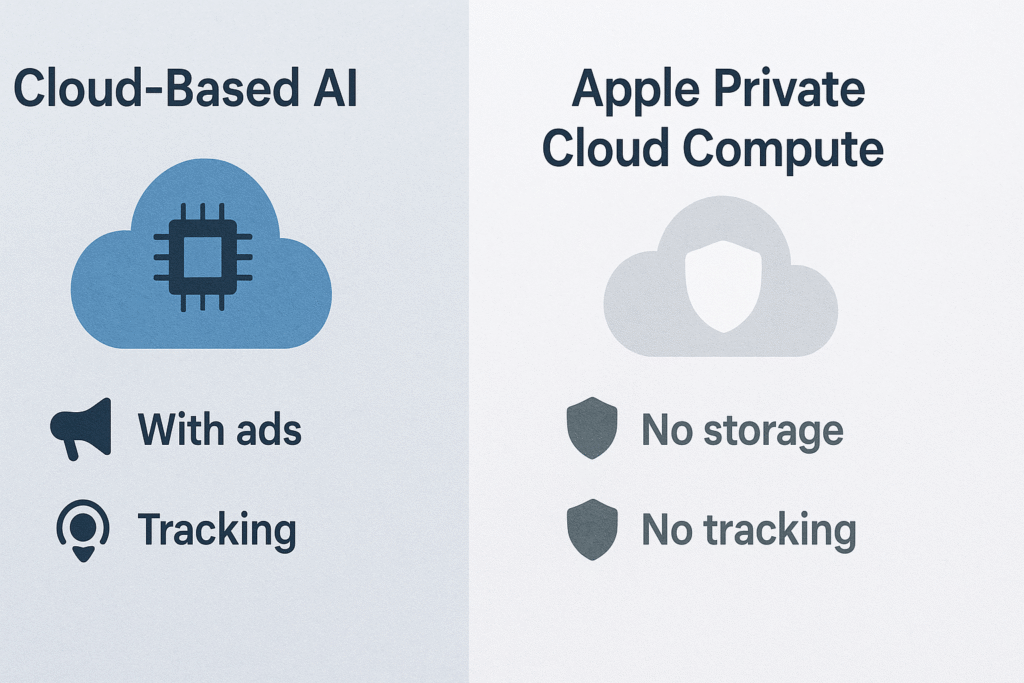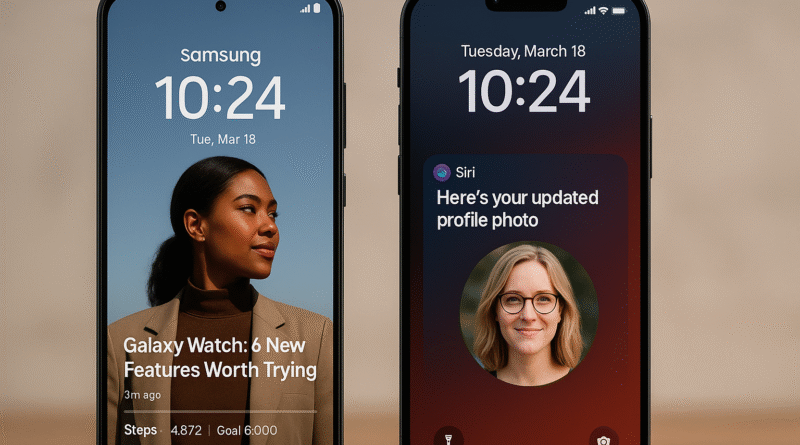5 Game-Changing Differences Between Samsung Glance and Apple Intelligence That Will Redefine Your Lock Screen in 2025
Samsung Glance vs Apple Intelligence Introduction- The Lock Screen Is the New Frontline of AI
It used to just tell you the time. Maybe display a notification or two.
But in 2025, your lock screen is no longer passive. It’s become a stage for AI-powered influence, a crucial, high-frequency touchpoint where companies fight for your attention before you even open an app.
And leading this silent war?
- Samsung’s Glance: a swipeable, immersive feed of news, entertainment, and shopping powered by AI personalization.
- Apple’s iOS 18 Lock Screen with Apple Intelligence: a quiet, refined interface enhanced by context-aware features that protect your time, focus, and privacy.
While both leverage artificial intelligence, the philosophy, intent, and impact behind their approaches couldn’t be more different.
In this article, we’ll explore the 5 game-changing differences between Samsung Glance and Apple Intelligence and what they reveal about the future of AI, digital ethics, and your most personal device.
Why It Matters: Your Lock Screen Is No Longer a Passive Moment
We unlock our phones hundreds of times a day, often without thinking. But those micro-moments are becoming prime opportunities for influence, distraction, or clarity.
That’s why the design and ethics of your lock screen experience truly matter.
Here’s what’s at stake:
1. The Lock Screen Is Now a Gateway to Your Mind
It’s no longer just “press and go.” Whether you realize it or not, what you see before you unlock your phone primes your brain, your emotions, decisions, and attention span for the next few minutes (or hours).
- Samsung Glance: grabs attention with visual noise and swipes
- Apple Intelligence: filters your world to reduce noise and show what matters
2. AI Is Becoming Invisible, And That’s Where the Risk Lives
Both Apple and Samsung are embedding AI into their lock screens. But one is doing it to help you focus, while the other is designed to optimize commercial engagement.
When AI becomes invisible, it also becomes less accountable. That’s why Apple’s transparent, opt-in approach matters more than ever.
3. Your Attention Is the Product Or the Priority
With Glance, your engagement time is sold to advertisers.
With Apple, your time is respected and protected.
The lock screen is now a philosophical battleground:
- Should tech companies profit from your first glance?
- Or should they protect it?
4. What’s Normalized Today Becomes Default Tomorrow
If ad-driven, dopamine-designed lock screens like Glance become the norm, we risk accepting distraction and surveillance as baseline design.
Apple Intelligence shows that ethical, empowering AI can be the standard if we demand it.
1. Purpose: Distraction Engine vs. Digital Assistant
Samsung Glance:
Glance transforms the lock screen into an endless scroll of AI-selected content, from bite-sized articles to product placements, celebrity trivia, and brand activations. It’s designed to:
- Increase screen time
- Boost ad impressions
- Create swipe-based habits before you even unlock
Glance is highly visual and attention-grabbing, with algorithms tuned to push what’s trending, clickable, and monetizable.
Apple Intelligence:
Apple’s approach is almost the opposite. The lock screen is not a content feed, but a smart interface that uses AI to:
- Prioritize critical notifications
- Suggest calendar changes
- Summarize messages or reminders
- Enhance widgets with predictive info (e.g., travel time, to-do alerts)
No flashy tiles. No dopamine bait. Just quiet, personal utility.
2. Privacy: Surveillance by Default vs. Privacy by Design

Samsung Glance:
While Glance offers personalization, it’s driven by:
- Behavioral tracking (what you swipe, read, tap)
- Demographic segmentation
- Third-party ad data integration
In many regions, Glance is pre-enabled by default on new Samsung devices. Disabling it can require digging through nested menus, and in some markets, it can’t be disabled at all.
That means your lock screen becomes a data mine even before you opt in.
Apple Intelligence:
Apple Intelligence works under a radical privacy framework:
- Most features run entirely on-device
- When cloud is needed, it uses Private Cloud Compute with no data storage
- No prompts are logged, saved, or linked to your Apple ID
- All AI features are opt-in by design
Apple doesn’t want your attention unless you allow it, and it never uses your data to train its models.
3. Personalization: Behavioral Tracking vs. Context Awareness
Glance Personalization:
Glance uses attention heatmaps, dwell time, and swipe patterns to figure out what to show you next. Its AI learns what you:
- Linger on
- Skip
- Click
- Convert into purchases
The result? A lock screen that feels “alive” but is optimized for engagement and commerce, not clarity.
Apple Intelligence Personalization:
Apple’s personalization isn’t based on behavior, but context:
- Where you are
- What’s on your calendar
- What you’re currently doing on-screen
- What messages or documents are open
It doesn’t sell or store that information, it just uses it in real time to offer context-aware assistance like:
- “Leave in 10 mins for your 2 PM at Starbucks”
- “That file you asked about is in Sarah’s last email.”
- “Your flight is delayed by 30 minutes.”
This is personalization without surveillance, a rare feat in today’s AI.
4. Monetization Model: Ad Real Estate vs. User-Centered Design
Glance: The Lock Screen as a Billboard
Glance is monetized via:
- Brand partnerships
- Native ads
- Sponsored tiles and product links
- Affiliate clicks
The more you swipe, the more Glance earns. Your lock screen becomes a media channel disguised as a utility.
Glance is part of InMobi’s larger adtech ecosystem, which thrives on impressions and behavioral segmentation.
Shocking sales tricks used by Glance.
Apple: The Lock Screen as a Filter
Apple doesn’t show ads. It doesn’t recommend content. It doesn’t push brands. It doesn’t track for monetization.
Instead, it monetizes through:
- Device sales
- iCloud+ and services
- Premium privacy as a brand differentiator
Apple’s lock screen is designed to protect your attention, not extract value from it.
5. Impact on Attention: Stimulus Overload vs. Cognitive Clarity
Glance Overstimulates
With endless tiles, visual noise, and new content every unlock, Glance creates:
- Micro-hits of dopamine
- Habitual lock-screen checking
- Constant low-level cognitive load
In short, it’s addictive by design, even if it’s not malicious. Over time, this trains your brain to expect novelty before productivity.
Apple Enhances Focus
Apple Intelligence’s lock screen features are built to:
- Reduce distractions
- Give only the most relevant info
- Create mental space, not clutter
- Keep you in control of when and how you engage
The result? A phone that respects your mind instead of fragmenting it. Ethical design in the age of AI.
Final Thoughts: The Lock Screen Is No Longer Neutral
Both Apple and Samsung have redefined what a lock screen can do.
But while Samsung wants your eyeballs, Apple wants to protect your mental bandwidth.
While Samsung’s Glance treats the lock screen as an advertising surface, Apple treats it as a responsibility zone, the place where you begin and end your interactions with technology.
The question isn’t just “Which looks better?”
It’s:
Which one is aligned with the kind of attention, focus, and autonomy you want in your life?
If you care about attention, clarity, and ethical design in the age of AI
Related Reads:
- 7 Powerful Reasons Why Apple Intelligence Is the Most Ethical AI in Your Pocket
- 5 Dark Concerns About Perplexity on Galaxy S26
- 10 Shocking Sales Tricks from Samsung Glance AI Lock Screen
Bonus: Which One Deserves Your First Glance?
| Feature | Samsung Glance | Apple Intelligence |
| Purpose | Engagement & monetization | User empowerment & clarity |
| Personalization | Behavior-based tracking | Contextual, ephemeral awareness |
| Monetization | Ad revenue model | Device + service revenue |
| Privacy | Enabled by default, behavior tracked | Opt-in, on-device processing |
| Experience | Visual overload, swipe-based | Minimalist, subtle, and assistive |
